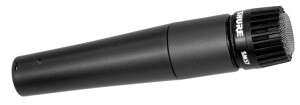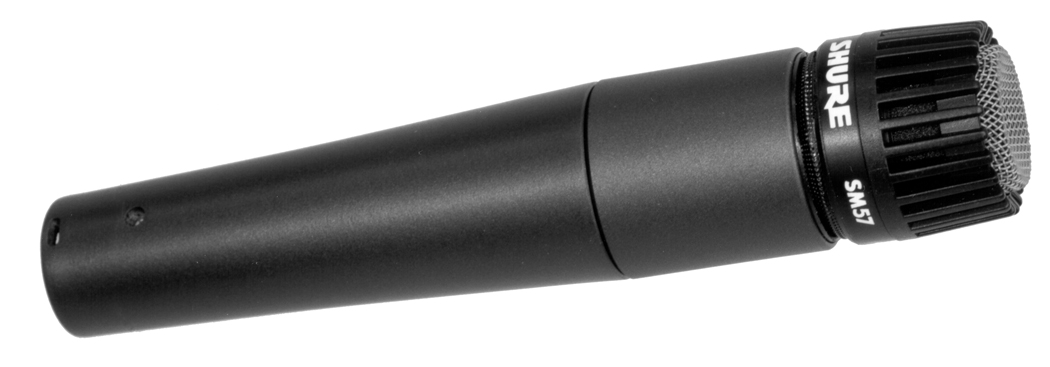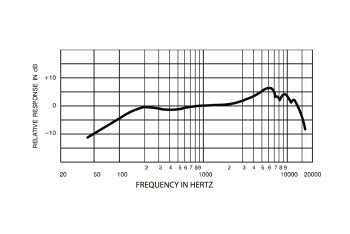The Shure SM57 arrived on the scene in 1965 and quickly became a fixture in the pro audio world. The versatile, solidly built, yet inexpensive dynamic mic is great for guitar cabinets, snare drums, horns and lots more, both onstage and in the studio. Besides its considerable studio and stage usage, it's been the presidential podium mic for decades.
Descended from the King’s mic
Shure microphones are known for their durability and solid construction, and the SM57 is one of the models that helped build that reputation. It was released at the same time as another legendary Shure mic, the SM58 (SM stands for “Studio Mic”). Both mics descended from the Shure Model 55, developed in 1939, and later known as “The Elvis Mic”; and from the Unidyne III, which came out in 1959.
Both the 57 and 58 use the same Unidyne III capsule, but their dissimilar grille designs make them better suited to different applications. The 58 has a round grille that’s better for reducing pops on vocals, whereas the 57’s flat grille allows closer positioning to the source, providing more proximity effect and thus fatter sounding reproduction. Thanks to its cardioid pattern, the SM57 offers directional pickup and feedback resistance. The pattern is also useful for avoiding leakage both live and in the studio.
57 Ways to mic
Why has the relatively inexpensive and unassuming-looking SM57 become such a stage and studio fixture? A number of factors come into play. Most importantly, it sounds good on a wide range of sources. Snare drums, toms, percussion, guitar cabinet and horns, among others. What’s more, because it’s a dynamic mic, it can withstand high sound pressure levels, so engineers can count on it not to overload, even on very loud sources. Finally, it’s built like a tank.
With all that it’s got going for it, the 57 sells for a mere $99, making it one of the biggest bargains in the music gear world. For comparison sake, just to replace the shockmount on a high-end studio condenser, such as the Neumann U87, you have to plunk down almost $400.
Because they’re so good and so inexpensive, multiple SM57s can be found in the mic collections of virtually every commercial studio and sound reinforcement company in business today, not to mention in a large number of home studios and band PA systems. And the 57 is not just for making music, it’s been the podium mic for every U.S. president from Lyndon Johnson to Barack Obama.
The Lore of the 57
The 57 has been the subject of rumors in terms of who used it and how, and we’ve now confirmed that the Michael Jackson did not use a 57 on “Billie Jean”, that was just a rumor that got wide play online. (He did use an SM7, which is from the same mic family as the 57.) The folks at Shure provided us with a couple of anecdotes about other rumors involving the SM57.
The first one involves Saturday Night Live. Sometime around the late 1970's, SNL replaced the SM58s used on the show with SM57s. According to Shure, “This started a flurry of rumors and conjecture that the SM57s must have 'better sound.' It was discovered later, however, that it was merely a decision made by the director because he preferred the look of the 57s.”
Another story features Cheap Trick and producer Roy Thomas Baker. “In the early 1980s, Cheap Trick was recording an album with Roy Thomas Baker at Pierce Arrow Recording in Evanston, IL. They needed some more SM57s and since they were just up the road from Shure’s headquarters in Niles, they called Michael Pettersen (Shure’s historian and the teller of this tale). Michael went into the storeroom and grabbed several we had laying around. These were older model SM57s and they had a distinct look – a different paint job and slightly different body design. Baker had a technique he used at the time to get a unique drum tone by laying ceramic tiles in the drum room. They recorded the album and returned the mics to Michael. Six months after this, Michael was at another recording studio and happened to overhear some interns talking about Roy Thomas Baker. They were saying that he carried older SM57s specifically to get his unique drum sound; no mention of the ceramic tiles, of course.”
Shure thing
Although myth making is intertwined in the history of the SM57, music making is the area where it really shines. This simple but solid dynamic mic has played a huge role in the history of recorded and live music — not to mention presidential speeches and press conferences — and will continue to do so into the future. Not bad for a $99 mic.
[Our thanks to Shure for the historical information.]






